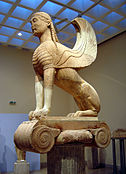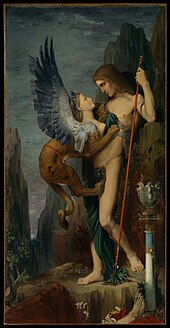Sphinx (greek)

(originally grave goods, approx. 63 cm high, Kerameikos Museum , Athens)
The Sphinx ( Greek Σφίγξ “strangler”) or Phix ( Φίξ ) in Greek mythology was the daughter of the monsters Typhon and Echidna and thus sister of Hydra , Chimera , Kerberos and Orthos . She was considered a demon of destruction and doom.
myth
Mostly the Sphinx was considered the daughter of Typhon and Echidna . According to another version, which Pausanias calls, she was an illegitimate, outcast daughter of Laios ; the Boioter Ukalegon is also mentioned as her father. The Sphinx stayed on Mount Phikeion , west of Thebes , and killed passing travelers, including, according to some versions, Haimon , the son of Creon . At least in versions from the 6th century BC. BC she gives her victims a riddle. Those who could not solve the riddle of the Sphinx were strangled by her and then devoured. The riddle was in the Greek original:
- τί ἐστιν ὃ μίαν ἔχον φωνὴν τετράπουν καὶ δίπουν καὶ τρίπουν γίνεται;
- What is it that is gifted with one voice, soon to be four-legged, two-legged and three-legged?
A freer, more classic translation into German reads: “What is possible on four feet in the morning, two at noon and three in the evening?” Oedipus solved the riddle whose answer is “man”: As a toddler he crawled on all fours , as an adult he walks on two legs, and in old age he needs a stick as a third leg. When Oedipus gave the correct answer, the Sphinx threw herself from her rock to her death. Thebes was liberated, but the tragic fate of Oedipus took its course.
- See also τί ἐστιν ὃ μίαν ἔχον φωνὴν τετράπουν καὶ δίπουν καὶ τρίπουν γίνεται; in the list of Greek phrases .
The cult of the riddle figure Sphinx was integrated into Greek mythology via the Minoan culture; previously perceived as a winged protective demon, the Sphinx appeared in folk legend and with Sophocles as a demon of destruction and doom. In Greek popular belief, the riddles of the Sphinx, which she is said to have learned from the muses, were imagined as if she had sung them with a seductive gesture. Puzzle poetry was popular in Greece; the Thebans are said to have gathered daily to discuss the new riddles of the Sphinx together. Only Oedipus seems to be equal to the disastrous Sphinx, even if he does not recognize the truth about his origin and thus does not escape the fate of killing his father and marrying his mother.
presentation
The Sphinx was represented by the Greeks as a winged lion with a woman's head, sometimes also as a woman with the paws and chest of a lioness, a snake tail and bird wings.
Sphinx of the Naxians , around 570 BC BC
(10 m high; Delphi Archaeological Museum )Marble statue, attic , around 530 BC Chr.
(423 cm high; Metropolitan Museum of Art , New York)Oedipus (right) with Sphinx and Hermes, around 440 BC BC
(Attic red-figure stamnos ; Louvre , Paris)Sphinx sculpture from 1882
( Lund University Botanical Garden , Sweden)
reception
In the fine arts and in the philosophy of cultural history of the 19th century, the encounter between the Sphinx and Oedipus is often interpreted as a symbolic key scene for “The Riddle of Woman” and for a conflicting gender relationship . This is particularly true of German, Belgian and French classicism and symbolism, as well as salon painting . Typical representatives are the artists Jean-Auguste-Dominique Ingres , Gustave Moreau , Fernand Khnopff , Franz von Stuck , Jules Michelet and Hermann Bahr .
See also
literature
- Erich Bethe : Theban hero songs. Investigations into the epics of the Theban-Argive saga. Hirzel, Leipzig 1891, pp. 19-22.
- Otto Höfer : Phix . In: Wilhelm Heinrich Roscher (Hrsg.): Detailed lexicon of Greek and Roman mythology . Volume 3.2, Leipzig 1909, column 2376 ( digitized version ).
- Johannes Ilberg : Sphinx II. The Sphinx in the Greek legend . In: Wilhelm Heinrich Roscher (Hrsg.): Detailed lexicon of Greek and Roman mythology . Volume 4, Leipzig 1915, Sp. 1363-1408 ( digitized version ).
- Günter Helmes , Søren Eberhardt : Reception of antiquities and gender difference. Sphinx with Helene Böhlau, Else Lasker-Schüler, Hugo von Hofmannsthal and Rainer Maria Rilke. In: Helmut Scheuer , Michael Grisko (eds.): Love, lust and suffering. On the culture of feeling around 1900. Kassel University Press, Kassel 1999, ISBN 978-3-933146-11-3 , pp. 258-283.
- Gebhardt, Harald and Ludwig, Mario: Of dragons, yetis and vampires. On the trail of mythical animals. BLV, Munich 2005, ISBN 3-405-16679-9 .
Web links
Individual evidence
- ↑ So already mentioned in Hesiod , Theogony 326
- ^ Pausanias , Journeys in Greece , 9, 26, 3--4.
- ↑ s. also Otto Weinreich : Ukalegon 3 . In: Wilhelm Heinrich Roscher (Hrsg.): Detailed lexicon of Greek and Roman mythology . Volume 6, Leipzig 1937, Col. 9-9 ( digitized version ).
- ↑ Süddeutsche Zeitung: wing being. Retrieved October 26, 2019 .
- ^ Cäcilia Rentmeister : Looking back in anger. the history of the Ö. In: Gabriele Dietze (Hrsg.): Overcoming speechlessness. Texts from the new women's movement (= Luchterhand Collection. Vol. 276). Luchterhand, Neuwied 1979, ISBN 3-472-61276-2 , pp. 221-272. Cäcilia Rentmeister : The riddle of the Sphinx. Matriarchal theses and the archeology of the non-Oedipal triangle . In: Brigitte Wartmann (Ed.): Female-male. cultural-historical traces of a repressed femininity. Aesthetics and Communication Verlag, Berlin 1980, ISBN 3-88245-003-7 , full texts




